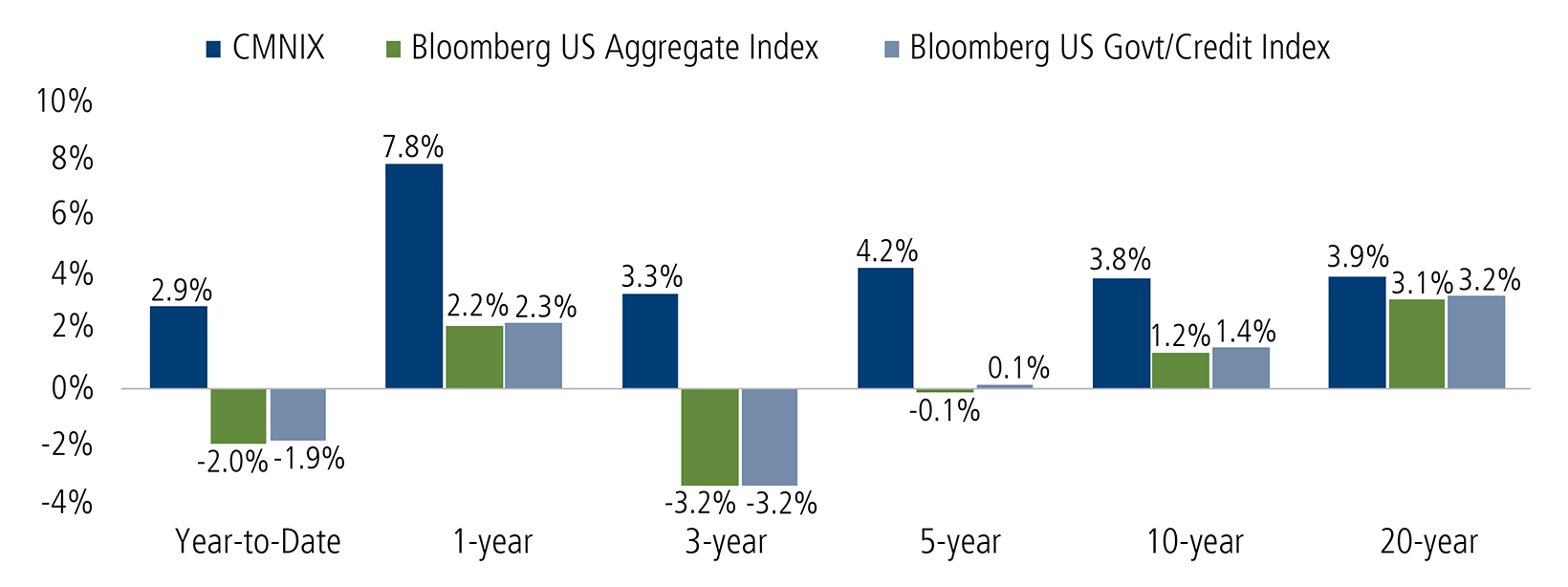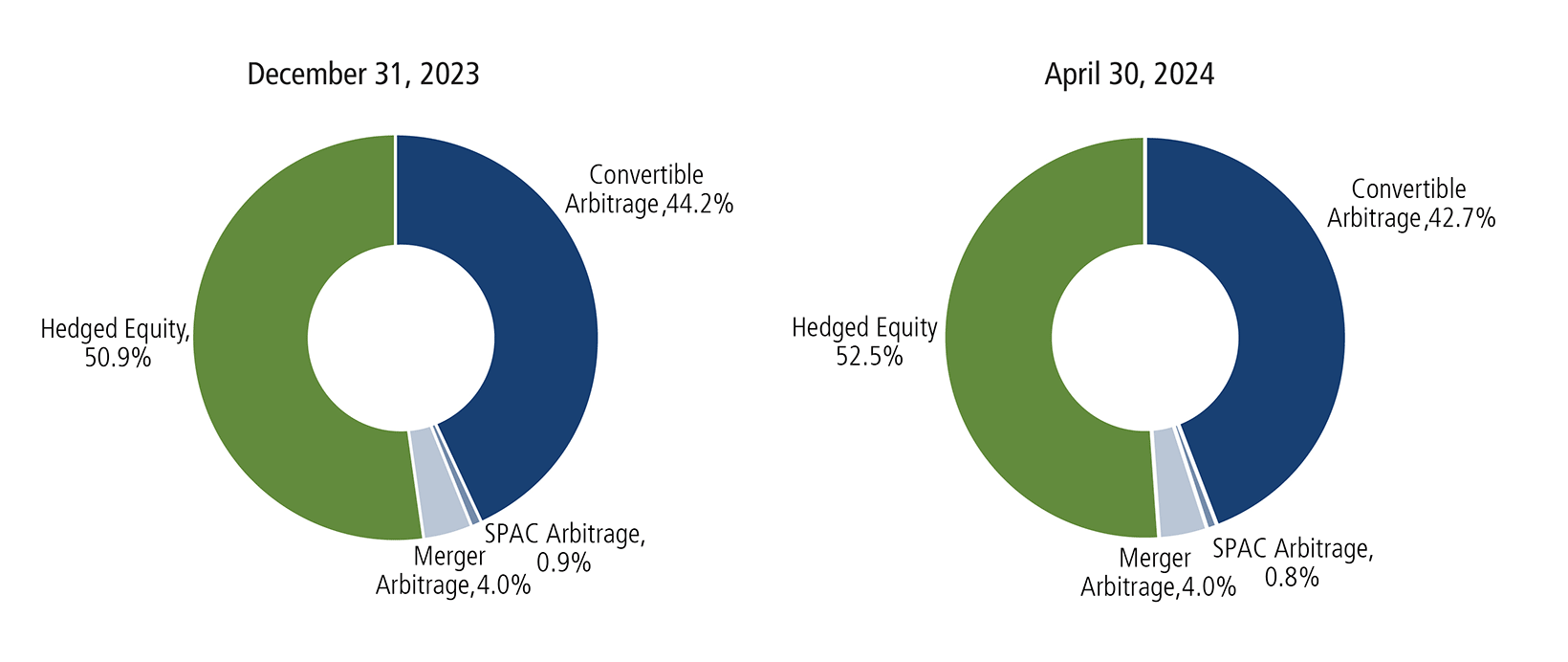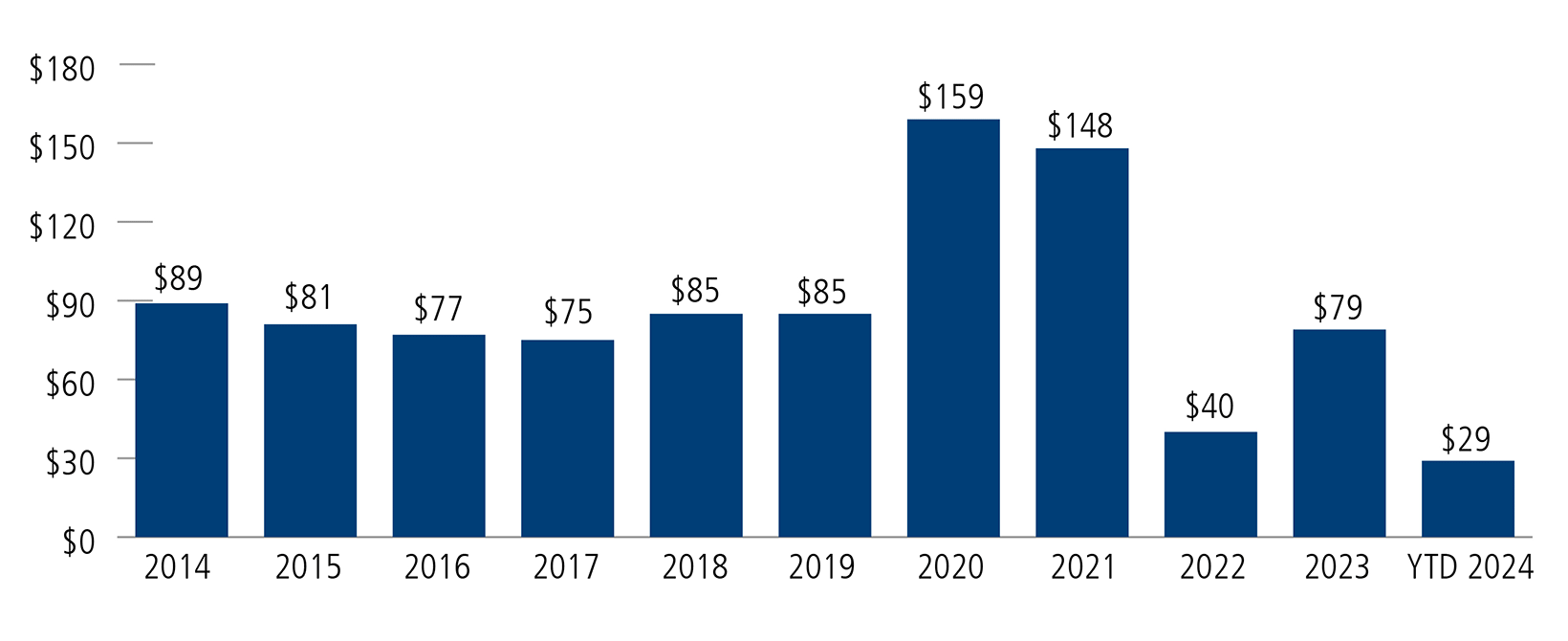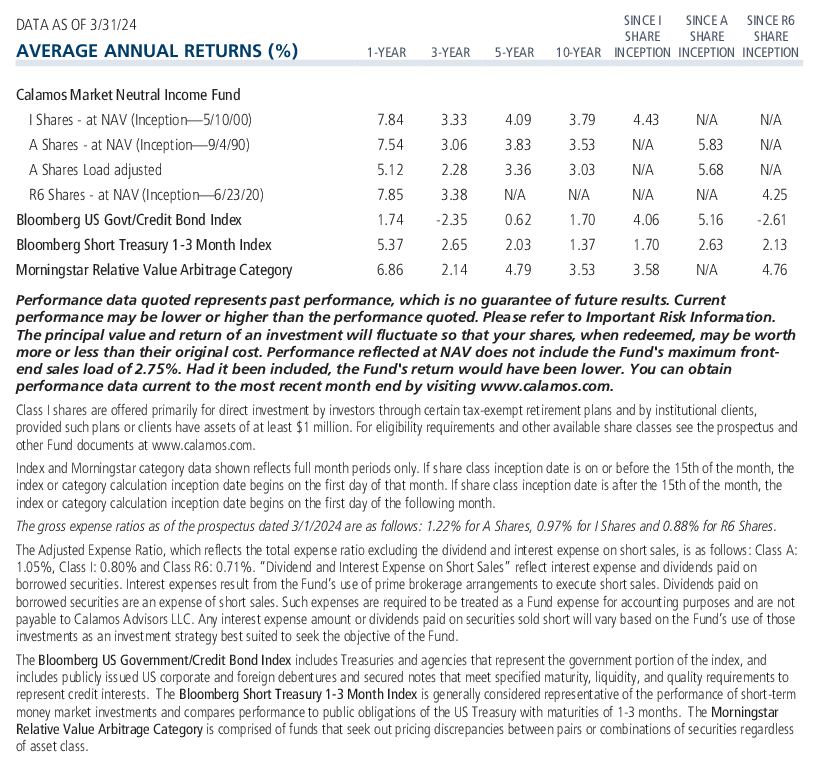 Investment Team Voices Home Page
Investment Team Voices Home Page
CMNIX: Advancing As Bonds Extend Their Slide
Eli Pars, CFA
About Calamos Market Neutral Income Fund
CMNIX is designed to enhance a traditional fixed income allocation.
The fund combines two complementary strategies—arbitrage and hedged equity—to pursue absolute returns and income that is not dependent on the level of interest rates.
Summary Points
- CMNIX has steadily advanced year-to-date, while the bond market has lost money.
- The fund has also outperformed bonds over short- and long-term periods, demonstrating its merits through interest rate cycles and different policy regimes.
- CMNIX is not exposed to the level of interest rate risks that bonds carry because it relies on alternative strategies (arbitrage and hedged equity).
In 2024, Calamos Market Neutral Income Fund has continued to demonstrate the benefits of an approach with little interest rate opportunity or risk. While the bond market has slid, the fund has posted a year-to-date gain of 2.9% through May 28, 2024.
We believe the opportunity of the fund’s approach is illustrated by its strong performance over the one-year period, with a gain that outperforms bond market benchmarks by more than 500 basis points. Moreover, CMNIX has continued to demonstrate its value as an alternative to cash. Even in an environment of unusually high short-term interest rates, Calamos Market Neutral Income Fund’s one-year return has still easily beaten a fed funds rate north of 5%, thanks to the many return levers that our arbitrage and hedged equity strategies provide.
CMNIX has outperformed bonds through interest rate and market cycles

Source: Morningstar. Performance data quoted represents past performance, which is no guarantee of future results. Current performance may be lower or higher than the performance quoted. Please refer to Important Risk Information. The principal value and return of an investment will fluctuate so that your shares, when redeemed, may be worth more or less than their original cost. All performance shown assumes reinvestment of dividends and capital gains distributions. The fund’s gross expense ratio as of the prospectus dated 3/1/2024 is 0.97% for Class I shares.
Positioning: Alternative strategies have given us an advantage over bonds … and cash
We actively manage the fund’s allocation between arbitrage and hedged equity. We have maintained a roughly equal balance over recent months and have modestly increased hedged equity in 2024.
We are finding opportunities in both hedged equity and arbitrage

Hedged Equity. The fund’s hedged equity strategy continues to be positioned with minimal exposure to the S&P 500 Index’s downside. Our hedged equity sleeve has the lowest beta to the S&P 500 Index in the history of the sleeve, a reflection of the favorable dynamics in the option market. More specifically, we’re getting more money to sell calls, while put prices are reasonable.
Even with this minimal exposure to the S&P 500’s downside, we have captured a respectable amount of the S&P 500’s gains, year-to-date.This favorable asymmetrical capture was supported in part by the positive standstill yield that our hedge can generate in an environment of higher short-term interest rates. The recent rise in the fed funds rate flows through to the option market in higher call and lower put prices. We intend to retain our higher delta hedge through 2024, as long as it is still the most attractive one available to us in the option market.
Arbitrage strategies. Our arbitrage strategies have performed well so far this year. Because the returns of these strategies are traditionally linked to overnight money, higher rates provide a boost. For example, within the convertible arbitrage strategy, the fund benefits from the rebate we get on our short positions, which is typically at the fed funds rate, less a fee for borrowing the stock (generally around 50 basis points). Slower to come through, but just as important, is the rise in coupons that we’ve seen as new issues come to the convertible market and old, lower-coupon bonds mature or are refinanced.
Convertible arbitrage represents the substantial majority of the arbitrage strategy. The dynamics of the new issuance market are an important part of our constructive view. New issuance has been robust in 2024, with global companies bringing $29 billion of new convertibles to market through April. The pace of issuance has accelerated even more this month, with US companies bringing over $10 billion to market last week alone—the highest weekly total in more than 15 years.
Importantly, the issuance we’ve seen this year has come to market with favorable terms, like lower conversion premiums and higher coupons. We’re finding opportunities to participate in higher-octane names, but with an attractive risk/reward skew thanks to the combination of the risk mitigation of the convertible structure and our hedge.
Although we don’t see $10-billion weeks becoming the norm, we believe issuance will remain strong for the next year or two. There are large maturity walls approaching in the investment-grade bond, high-yield debt and convertible markets. At current interest rate levels, many issuers seeking to refinance will likely decide that convertibles are the most attractive choice. We expect this environment will also lead to increased breadth in the convertible market, including more investment-grade issuance.
Global convertible issuance creates opportunities for convertible arbitrage

Source: BofA Global Research. Year-to-date data through April 30, 2024.
What’s next for CMNIX?
As investors continue to focus on what the Fed will do next and when, our team is confident in the long-term potential of CMNIX as a fixed income alternative. We recognize that we can’t see into the future with certainty, so we work to position the fund for as many potential outcomes as possible. Through the years, this has served our shareholders well, and we believe it will continue to be the case—no matter where we happen to be in the interest rate, economic or market cycles.
Before investing, carefully consider the fund’s investment objectives, risks, charges and expenses. Please see the prospectus and summary prospectus containing this and other information which can be obtained by calling 1-866-363-9219. Read it carefully before investing.

As of May 27, 2024, the federal funds rate was 5.33%. Source: Federal Reserve Bank of St. Louis. The federal funds rate is the interest rate at which depository institutions trade federal funds (balances held at Federal Reserve Banks) with each other overnight.
Diversification and asset allocation do not guarantee a profit or protect against a loss. Alternative strategies entail added risks and may not be appropriate for all investors. Indexes are unmanaged, not available for direct investment and do not include fees and expenses.
Opinions, estimates, forecasts, and statements of financial market trends that are based on current market conditions constitute our judgment and are subject to change without notice. The views and strategies described may not be appropriate for all investors. References to specific securities, asset classes and financial markets are for illustrative purposes only and are not intended to be, and should not be interpreted as, recommendations.
Indexes are unmanaged, do not include fees or expenses and are not available for direct investment. The S&P 500 Index is considered a measure of the US equity market. The Bloomberg US Aggregate Index measures the performance of investment grade bonds. The Bloomberg US Government/Credit Bond Index includes Treasuries and agencies that represent the government portion of the index, and includes publicly issued US corporate and foreign debentures and secured notes that meet specified maturity, liquidity, and quality requirements to represent credit interests.
Important Risk Information. An investment in the Fund(s) is subject to risks, and you could lose money on your investment in the Fund(s). There can be no assurance that the Fund(s) will achieve its investment objective. Your investment in the Fund(s) is not a deposit in a bank and is not insured or guaranteed by the Federal Deposit Insurance Corporation (FDIC) or any other government agency. The risks associated with an investment in the Fund(s) can increase during times of significant market volatility. The Fund(s) also has specific principal risks, which are described below. More detailed information regarding these risks can be found in the Fund’s prospectus.
The principal risks of investing in the Calamos Market Neutral Income Fund include: equity securities risk consisting of market prices declining in general, convertible securities risk consisting of the potential for a decline in value during periods of rising interest rates and the risk of the borrower to miss payments, synthetic convertible instruments risk, convertible hedging risk, covered call writing risk, options risk, short sale risk, interest rate risk, credit risk, high yield risk, liquidity risk, portfolio selection risk, and portfolio turnover risk.
Foreign security risk. As a result of political or economic instability in foreign countries, there can be special risks associated with investing in foreign securities, including fluctuations in currency exchange rates, increased price volatility and difficulty obtaining information. In addition, emerging markets may present additional risk due to the potential for greater economic and political instability in less developed countries.
024023 0524
Cookies
This website uses cookies. By continuing to use this website, you consent to the use of cookies. Learn more about our cookie usage.

